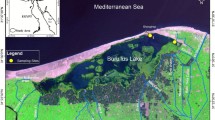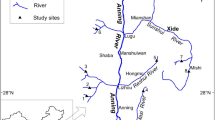Abstract
The food of lake-dwelling Erpobdella octoculata, Glossiphonia complanata and Helobdella stagnalis was determined by exposing potential prey organisms to leech attack in dishes, in the laboratory. For each prey species, four experimental regimes were used; these contained prey and leeches of different sizes.
E. octoculata fed extensively on chironomids and oligochaetes, G. complanata on gastropods, oligochaetes and chironomids, and H. stagnalis on a wide variety of prey, including oligochaetes, chironomids, gastropods, Asellus and mayflies. Feeding was most intense during periods of darkness. Findings are compared with those of previous studies.
Similar content being viewed by others
References
Aston, R. J. & Brown, D. J. A. 1975. Local and seasonal variations in populations of the leech Erpobdella octoculata (L.) in a polluted river warmed by condenser effluents. Hydrobiologia 47: 347–366.
Autrum, H. 1936. Hirudineen. In: H. G. Bronns, Klassen und Ordnungen des Tierreichs. Band IV, Abt. 111, Buch 4, Teil I: 1–6.
Bennike, S. A. B. 1943. Contributions to the ecology and biology of the Danish freshwater leeches (Hirudinea). Folia Limnol. Scand. 2: 1–109.
Cross, W. H. 1976. A study of predation rates of leeches on tubificid worms under laboratory conditions. Ohio J. Sci. 76: 164–166.
Davies, R. W. & Everett, R. P. 1975. The feeding of four species of freshwater Hirudinoidea in Southern Alberta. Verh. Internat. Verein. Limnol. 19: 2816–2827.
Davies, R. W. & Reynoldson, T. B. 1969. The incidence and intensity of predation on lake-dwelling triclads in the laboratory. Ecology 50: 845–853.
Davies, R. W. & Reynoldson, T. B. 1971. The incidence and intensity of predation on lake-dwelling triclads in the field. J. Anim. Ecol. 40: 191–214.
Elliott, J. M. 1973. The diel activity pattern, drifting and food of the leech Erpobdella octoculata (L.) (Hirudinea: Erpobdellidae) in a Lake District stream. J. Anim. Ecol. 42: 449–459.
Greene, K. L. 1974. Experiments and observations on the feeding behaviour of the freshwater leech Erpobdella octoculata (L.) (Hirudinea: Erpobdellidae). Arch. Hydrobiol. 74: 87–99.
Griffiths, K. J. & Holling, C. S. 1969. A competition submodel for parasites and predators. Can. Ent. 101: 785–818.
Haka, P., Holopainen, I. J., Ikonen, E., Leisma, A., Paasivirta, L., Saaristo, P., Sarvala, J. & Sarvala, M. 1974. Pääjarven pobjaeläimisto. Luonnon Tutkija 78: 157–173.
Harding, W. A. 1910. A revision of the British leeches. Parasitology 3: 130–201.
Harding, W. A. & Moore, J. P. 1927. The fauna of British India: Hirudinea. London.
Hassell, M. P. 1966. Evaluation of parasite or predator responses. J. Anim. Ecol. 35: 65–75.
Hilsenhoff, W. L. 1963. Predation by the leech Helobdella stagnalis on Tendipes plumosus (Diptera: Tendipedidae) larvae. Ann. Ent. Soc. Amer. 56: 252.
Holling, C. S. 1959. Some characteristics of simple types of predation and parasitism. Can. Ent. 91: 385–398.
Holling, C. S. 1965. The functional response of predators to prey density and its role in mimicry and population regulation. Mem. Ent. Soc. Can. 45: 1–60.
Holling, C. S. 1967. The functional response of invertebrate predation to prey density. Mem. Ent. Soc. Can. 48: 1–86.
Jarry, D. 1960. Une curieuse coaction de parasitisme: l'association entre Glossiphonia complanata et Erpobdella octoculata. Terre et Vie 107: 51–55.
Jung, T. 1955. Zur Kenntnis der Ernährungsbiologie der in dem Raum zwischen Harz und Heide vorkommenden Hirudineen. Zool. Jahrb. 66: 79–128.
Klemm, D. J. 1975. Studies on the feeding relationships of leeches (Annelida: Hirudinea) as natural associates of mollusks. Sterkiana 58: 1–50and 59: 1–20.
Lang, C. 1974. Macrofaune des fonds de cailloux du Léman. Schweiz. Z. Hydrol. 36: 301–350.
MacLeod, P. & Valiela, I. 1975. The effect of density and mutual interference by a predator: a laboratory study of predation by the nudibranch Coryphella rufibranchialis on the hydroid Tubularia larynx. Hydrobiologia 47: 339–346
Mann, K. H. 1953. The life history of Erpobdella octoculata (L.). J. Anim. Ecol. 22: 199–207.
Mann, K. H. 1955. The ecology of the British freshwater leeches. J. Anim. Ecol. 24: 98–119.
Mann, K. H. 1962. Leeches (Hirudinea), their structure, physiology, ecology and embryology. Pergamon Press, Oxford.
Mann, K. H. 1964. A key to the British freshwater leeches. F.B.A. Scient. Publ. No. 14: 1–50.
Mathers, C. K. 1948. The leeches of the Okoboji Region. Iowa Acad. Sci. 55: 397–425.
Mellanby, H. 1938. Animal life in freshwater: a guide to British fresh water invertebrates. Methuen and Co. Ltd., London.
Meuche, A. 1937. Nahrungsuntersuchungen an den Schlundegeln Herpobdella octoculata und Herpobdella testacea. Arch. Hydrobiol. 31: 501–507.
Miller, J. A. 1929. The leeches of Ohio. Contrib. Franz Theodore Stone Lab. 2: 1–38.
Miller, J. A. 1937. A study of the leeches of Michigan with a key to orders, sub-order and species. Ohio J. Sci. 37: 85–90.
Moore, J. E. 1964. Notes on the leeches (Hirudinea) of Alberta. Nat. Mus. Canad. Natur. Hist. Papers 27: 1–15.
Moore, J. E. 1966. Further notes on the Alberta leeches (Hirudinea). Nat. Mus. Canad. Natur. Hist. Papers 32: 1–11.
Moore, J. P. 1901. The Hirudinea of Illinois. Bull. III, State Lab. Nat. Hist. 5: 479–547.
Moore, J. P. 1912. The leeches of Minnesota. Part III. Classification. Zool. Series J: 68–150.
Moore, J. P. 1920. The leeches of Lake Maxinkuckee. In: Lake Maxinkuckee: A physical and biological survey. Dept. Conserv., State of Indiana 2: 87–95.
Moquin-Tandon, A. 1846. Monographie de la famille des Hirudinées. Nouvelle edition, Paris.
Murdoch, W. W. 1969. Switching in general predators: experiments on predation specificity and stability in prey populations. Ecol. Monogr. 39: 335–354
Nachtrieb, H. F., Hemingway, E. E. & Moore, J. P. 1912. The leeches of Minnesota. Geol. Nat. Hist. Survey Minn., Zool. Ser. 5: 1–150.
Pawlowski, L. K. 1936. Zur Ökologie der Hirudineen-fauna der Wigryseen. Arch. Hydrobiol. Rybact. 10: 1–47.
Pawlowski, L. K. 1955. Observations biologiques sur les sangsues. Bull. Soc. Sci. Lett., Lodz (III) 6: 1–21.
Pennak, R. W. 1953. Freshwater invertebrates of the United States. Ronald Press Co., N.Y.
Percival, E. & Whitehead, H. 1929. A quantitative study of the fauna of some types of stream-bed. J. Ecol. 17: 282–314.
Pickavance, J. R. 1968. The ecology of Dugesia tigrina (Girard) an American immigrant planarian. Unpublished Ph. D. thesis, University of Liverpool.
Reynoldson, T. B. 1961. Observations on the occurrence of Asellus (Isopoda, Crustacea) in some lakes in northern Britain. Verh. int. Ver. Limnol. 14: 988–994.
Sapkarev, J. A. 1968. The taxonomy and ecology of leeches (Hirudinea) of Lake Mendota, Wisconsin. Trans. Wisconsin Akad. Sc. Arts. Lett. 56: 225–253.
Sawyer, R. T. 1972. North American freshwater leeches. Illinois Biological Monographs 46: 1–154.
Schürch, M. & Walter, J. E. 1978. Über die Diäten von Egeln (Hirudinea) und Plattwürmern (Turbellaria: Tricladida). Arch. Hydrobiol. 83: 272–276.
Thut, R. N. 1969. A study of the profundal bottom fauna of Lake Washington. Ecol. Monogr. 39: 79-l00.
Ussing, H. J. 1929. Om nogle sjaeldne og lidet kendte danske Hirudinea. Vidensk. Meddel. Dansk. Naturh. Foren. 88: 203–220.
Waffle, E. L. 1963. An ecological study of the Iowa Glossiphoniidae (Annelida: Hirudinea) with emphasis on feeding and reproductive habits. M.S. Thesis, Univ. Iowa.
Warwick, T. & Mann, K. H. 1960. The freshwater leeches of Scotland. Ann. Mag. nat. Hist. 3: 25–34.
Wharton, G. W. & Arlian, L. G. 1972. Predatory behaviour of the mite Cheyletus aversos. Anim. Behav. 20: 719–723.
Wilkialis, J. 1970. Investigations on the biology of leeches of the Glossiphoniidae family. Zoologica Poloniae 20: 29–54.
Young, J. O. 1973. The occurrence of Microturbellaria in some British lakes of diverse chemical content. Arch. Hydrobiol. 72: 202–224.
Young, J. O. & Reynoldson, T. B. 1965. A laboratory study of predation on lake-dwelling triclads. Hydrobiologia 26: 307–313.
Zar, J. H. 1974. Biostatistical analysis. Prentice-Hall, Inc., Englewood Cliffs, N.J.
Author information
Authors and Affiliations
Rights and permissions
About this article
Cite this article
Young, J.O., Ironmonger, J.W. A laboratory study of the food of three species of leeches occurring in British lakes. Hydrobiologia 68, 209–215 (1980). https://doi.org/10.1007/BF00018828
Received:
Issue Date:
DOI: https://doi.org/10.1007/BF00018828




